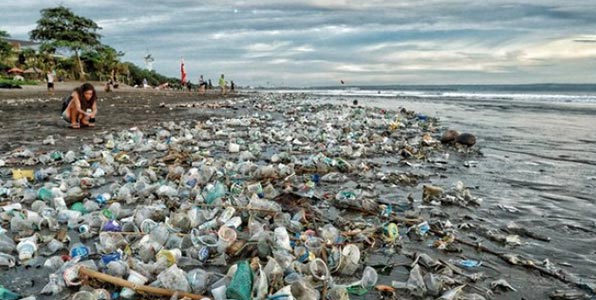Bali has been a tourist hotspot for many years, with millions of visitors flocking to the Indonesian island annually. While beautiful beaches and culture are everywhere – so is plastic. One British diver recently showed just how bad the problem is on a diving trip off the coast of Bali.
The video, featuring Richard Horner, shows plastic waste, bags, plastic baskets, straws, buckets, sheets, cups, bottles, and more, scattered throughout the sea. There appeared to not only be a thick layer of plastic waste on the water’s surface but covering the reefs as well.
Richard, who went diving to catch a glimpse of manta rays which use the area as a cleaning station, was horrified by what he saw. During his entire experience, he only sighted one ray.
According to Richard, who posted his video on Facebook, the manta rays probably “decided not to bother”.
“Surprise, surprise, there weren’t many mantas there at the cleaning station today,” he said.
Not only was there no presence of manta rays, but other marine life as well.
Plastic is not only an eyesore but a dangerous addition to oceans around the world. Filter feeders swallow large volumes of water to eat plankton but can consume plastic particles at the same time. Whales and sharks, in particular, can find themselves unable to absorb nutrients from their food due to the amount of ingested plastic.
Pollution is a global problem, but Indonesia is one of the worst polluters. Studies show Indonesia is responsible for at least ten percent of the world’s waste. In Jakarta, Indonesia’s capital city, it’s not uncommon to see waterways laden with plastic, and rubbish dumps everywhere. To deal with the problem, Bali has now banned plastic bags, straws, and Styrofoam containers.
However, Richard Horner’s observations while diving is only the tip of the iceberg. Plastic pollution is now prevalent on every beach in the world – even those that are uninhabited. Microplastics have been found embedded in Arctic ice, and eight million pieces of plastic enter the ocean every day.
While famous tourist beaches face an ongoing battle with plastic, so too does the open ocean. There are around 5.25 trillion macro and microplastic pieces in the sea weighing nearly 270,000 tonnes. What’s more, out of all marine debris, up to 90 percent is plastic.
The oceans are suffering, and marine life is as well. All marine turtles have ingested plastic, followed by 59 percent of whales, nearly 40 percent of seals, and around 40 percent of seabirds. One billion seabirds die from plastic pollution every year along with 100,000 marine mammals and turtles.
While Bali is putting steps in place to battle the problem, it will take years to make a dent in the issue.

